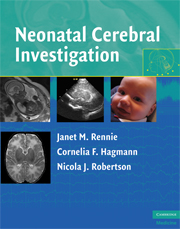Book contents
- Frontmatter
- Contents
- List of contributors
- Preface
- Acknowledgements
- Glossary and abbreviations
- Section I Physics, safety, and patient handling
- 1 Principles of ultrasound
- 2 Principles of EEG
- 3 Principles of magnetic resonance imaging and spectroscopy
- Section II Normal appearances
- Section III Solving clinical problems and interpretation of test results
- Index
- References
1 - Principles of ultrasound
from Section I - Physics, safety, and patient handling
Published online by Cambridge University Press: 07 December 2009
- Frontmatter
- Contents
- List of contributors
- Preface
- Acknowledgements
- Glossary and abbreviations
- Section I Physics, safety, and patient handling
- 1 Principles of ultrasound
- 2 Principles of EEG
- 3 Principles of magnetic resonance imaging and spectroscopy
- Section II Normal appearances
- Section III Solving clinical problems and interpretation of test results
- Index
- References
Summary
Discovery of ultrasound
The term ultrasound refers to sound with a frequency above that which can be detected by the human ear. The audible frequency range lies between 20 Hz and 20 kHz (one hertz equals one cycle per second, one kilohertz equals one thousand cycles per second), whereas the frequencies of sound waves used for diagnostic applications in medicine are of the order of one thousand times higher than this, with a range between 1 and 10 MHz (megahertz = one million hertz). Ultrasound imaging relies on the so-called pulse echo principle, which involves emitting a short burst of ultrasound and then listening for the returning “echo” after the sound has been reflected off appropriate surfaces. This is exactly the mechanism which has been employed by bats for millions of years to navigate their way around dark caves and to catch flying insects. Human interest in navigation using sound waves was significantly enhanced (if not initially inspired) by the sinking of the Titanic, which occurred when the ship collided with an iceberg in April 1912. Within a few years, ships were widely equipped with SONAR (Sound Navigation And Ranging) devices, which emit sound waves beneath the surface of the sea, and detect echoes from large objects within a radius of several miles. The technology advanced considerably during both world wars as it was utilized to detect submarines and mines.
- Type
- Chapter
- Information
- Neonatal Cerebral Investigation , pp. 1 - 8Publisher: Cambridge University PressPrint publication year: 2008



